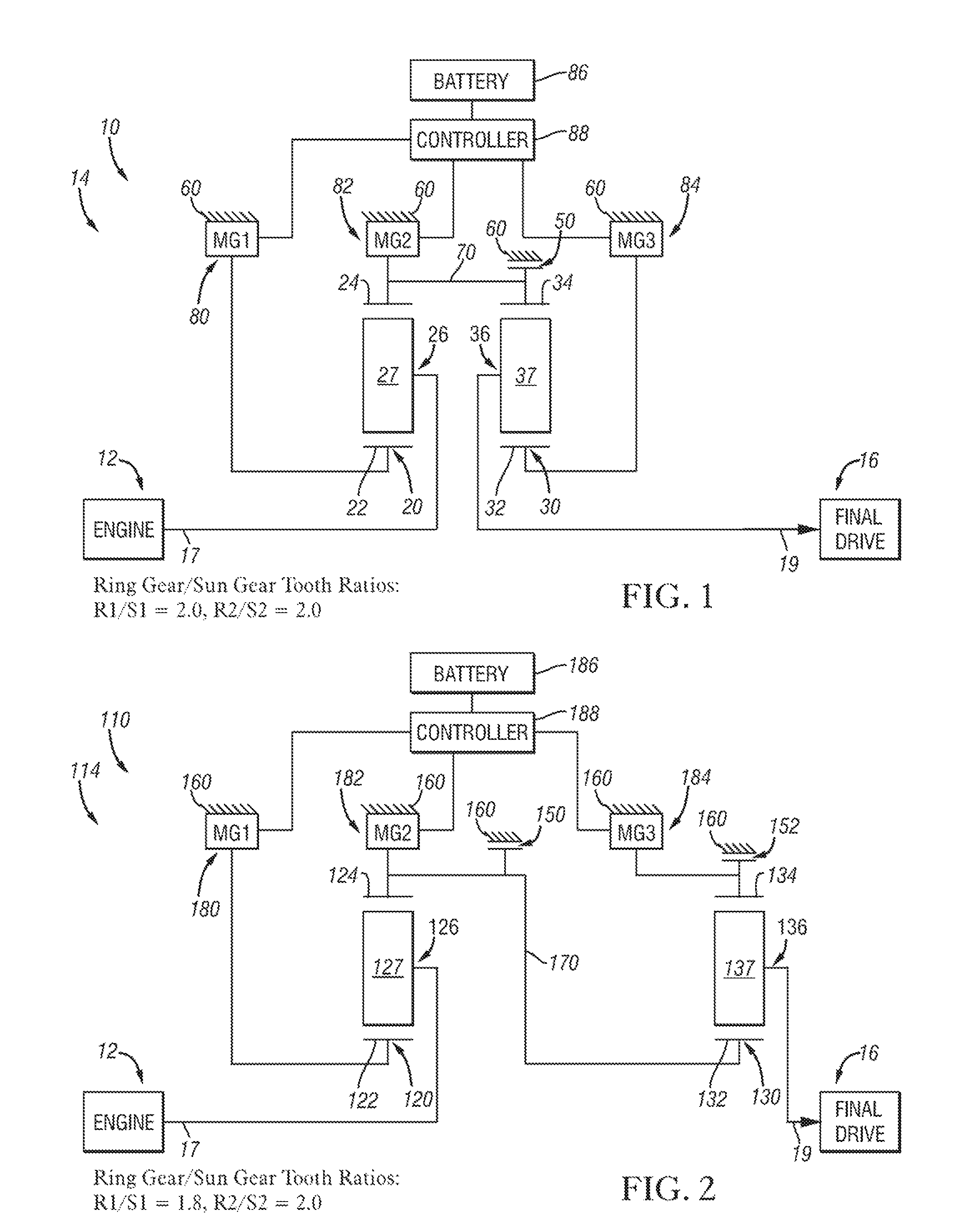Hybrid architecture incorporating three motor generators and brakes
a hybrid vehicle and generator technology, applied in the direction of electric propulsion mounting, electric propulsion, transportation and packaging, etc., can solve the problems of limited market penetration, the size of the electric motor, and the cost of the hybrid vehicle is the power capacity of the battery, so as to reduce the need for massive and expensive energy storage and minimize the operation of the motor/generator
- Summary
- Abstract
- Description
- Claims
- Application Information
AI Technical Summary
Benefits of technology
Problems solved by technology
Method used
Image
Examples
second exemplary embodiment
DESCRIPTION OF A SECOND EXEMPLARY EMBODIMENT
[0044]With reference to FIG. 2, a powertrain 110 is shown, including an engine 12 connected to another embodiment of the improved electrically variable transmission (EVT), designated generally by the numeral 114. Transmission 114 is designed to receive at least a portion of its driving power from the engine 12. As shown, the engine 12 has an output shaft that serves as the input member 17 of the transmission 114. A transient torque damper (not shown) may also be implemented between the engine 12 and the input member 17 of the transmission.
[0045]In the embodiment depicted the engine 12 may be a fossil fuel engine, such as a gasoline or diesel engine which is readily adapted to provide its available power output typically delivered at a selectable number of revolutions per minute (RPM).
[0046]Irrespective of the means by which the engine 12 is connected to the transmission input member 17, the transmission input member 17 is operatively conne...
third exemplary embodiment
DESCRIPTION OF A THIRD EXEMPLARY EMBODIMENT
[0057]With reference to FIG. 3, a powertrain 210 is shown, including an engine 12 connected to another embodiment of the improved electrically variable transmission (EVT), designated generally by the numeral 214. Transmission 214 is designed to receive at least a portion of its driving power from the engine 12. As shown, the engine 12 has an output shaft that serves as the input member 17 of the transmission 214. A transient torque damper (not shown) may also be implemented between the engine 12 and the input member 17 of the transmission.
[0058]In the embodiment depicted the engine 12 may be a fossil fuel engine, such as a gasoline or diesel engine which is readily adapted to provide its available power output typically delivered at a selectable number of revolutions per minute (RPM).
[0059]Irrespective of the means by which the engine 12 is connected to the transmission input member 17, the transmission input member 17 is operatively connec...
fourth exemplary embodiment
DESCRIPTION OF A FOURTH EXEMPLARY EMBODIMENT
[0070]With reference to FIG. 4, a powertrain 310 is shown, including an engine 12 connected to another embodiment of the improved electrically variable transmission (EVT), designated generally by the numeral 314. Transmission 314 is designed to receive at least a portion of its driving power from the engine 12. As shown, the engine 12 has an output shaft that serves as the input member 17 of the transmission 314. A transient torque damper (not shown) may also be implemented between the engine 12 and the input member 17 of the transmission.
[0071]In the embodiment depicted the engine 12 may be a fossil fuel engine, such as a gasoline or diesel engine which is readily adapted to provide its available power output typically delivered at a selectable number of revolutions per minute (RPM).
[0072]Irrespective of the means by which the engine 12 is connected to the transmission input member 17, the transmission input member 17 is operatively conne...
PUM
 Login to View More
Login to View More Abstract
Description
Claims
Application Information
 Login to View More
Login to View More - R&D
- Intellectual Property
- Life Sciences
- Materials
- Tech Scout
- Unparalleled Data Quality
- Higher Quality Content
- 60% Fewer Hallucinations
Browse by: Latest US Patents, China's latest patents, Technical Efficacy Thesaurus, Application Domain, Technology Topic, Popular Technical Reports.
© 2025 PatSnap. All rights reserved.Legal|Privacy policy|Modern Slavery Act Transparency Statement|Sitemap|About US| Contact US: help@patsnap.com



